
Concept explainers
(a)
Interpretation:

Concept Introduction:
Atomic number of an atom is equal to the number of protons in it. Atomic number is represented by Z.
Answer to Problem 19P
The atomic number for isotope of fluorine A and B is 9.
Explanation of Solution
In the molecular model of fluorine, orange balls represent neutrons, whereas blue balls represent protons. Since the number of protons from given molecular models A and B is 9, the atomic number becomes 9 for A and B both, as the atomic number is equal to the number of protons in that atom.
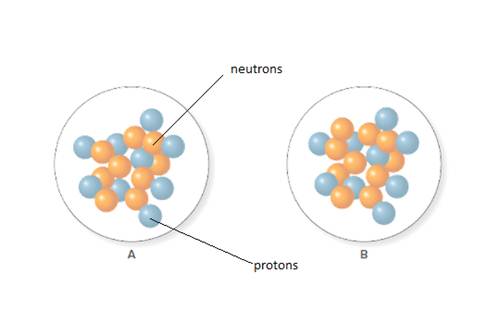
(b)
Interpretation:
Mass number for each isotope of fluorine given below should be predicted.
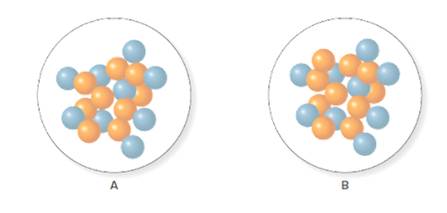
Concept Introduction:
The mass number is equal to the number of protons and neutrons in an atom.
Answer to Problem 19P
The atomic number for isotope of fluorine A and B is 18 and 19 respectively.
Explanation of Solution
From the molecular model of an isotope of fluorine, the number of neutrons can be counted. Thus, the number of neutrons in A and B is 9 and 10 respectively.
As
For A and B, the mass number will be calculated as follows:
(c)
Interpretation:
Number of protons for each isotope of fluorine given below should be predicted.
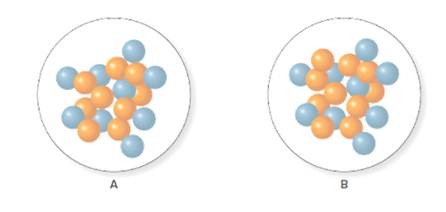
Concept Introduction:
The number of protons is equal to the atomic number of that atom.
Answer to Problem 19P
The number of protons in isotope of fluorine A and B is 9.
Explanation of Solution
In the molecular model of fluorine, protons are represented by blue balls. Thus, the number of protons in A and B will be calculated by counting the number of blue balls in A and B in the given figure as follows:
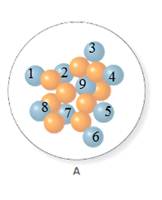
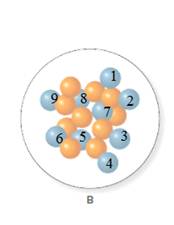
Thus, the number of protons in A and B is 9.
(d)
Interpretation:
The number of neutrons for each isotope of fluorine given below should be predicted.

Concept Introduction:
The mass number is the sum of all the protons and neutrons present in an atom. Thus, the number of neutrons can be calculated simply by subtracting the number of protons from the mass number of that atom.
Answer to Problem 19P
The number of neutrons in A and B is 9 and 10 respectively.
Explanation of Solution
For A, the mass number and number of protons are 18 and 9 respectively. Thus, the number of neutrons in A will be calculated as follows:
For B the mass number and number of protons are 19 and 9 respectively. Thus, the number of neutrons in B will be calculated as follows:
(e)
Interpretation:
The isotope symbol for each isotope of fluorine given below should be predicted.

Concept Introduction:
Isotopes are the compounds having the same atomic number but different
To write an isotope symbol atomic number (Z) is written on the lower left side and atomic mass(A) is written on the upper left side of an element.
Answer to Problem 19P
The isotope symbol for A and B is
Explanation of Solution
For A, the mass number and atomic numbers are 18 and 9 respectively. Thus, the isotope symbol for A will be represented as follows:
For B, the mass number and atomic numbers are 19 and 9 respectively. Thus, the isotope symbol for B will be represented as follows:
Want to see more full solutions like this?
Chapter 10 Solutions
GENERAL ORGANIC+BIOLOG.CHEM.(LL)-PKG.
 Introductory Chemistry: A FoundationChemistryISBN:9781337399425Author:Steven S. Zumdahl, Donald J. DeCostePublisher:Cengage Learning
Introductory Chemistry: A FoundationChemistryISBN:9781337399425Author:Steven S. Zumdahl, Donald J. DeCostePublisher:Cengage Learning World of Chemistry, 3rd editionChemistryISBN:9781133109655Author:Steven S. Zumdahl, Susan L. Zumdahl, Donald J. DeCostePublisher:Brooks / Cole / Cengage Learning
World of Chemistry, 3rd editionChemistryISBN:9781133109655Author:Steven S. Zumdahl, Susan L. Zumdahl, Donald J. DeCostePublisher:Brooks / Cole / Cengage Learning Chemistry: The Molecular ScienceChemistryISBN:9781285199047Author:John W. Moore, Conrad L. StanitskiPublisher:Cengage Learning
Chemistry: The Molecular ScienceChemistryISBN:9781285199047Author:John W. Moore, Conrad L. StanitskiPublisher:Cengage Learning Introductory Chemistry: A FoundationChemistryISBN:9781285199030Author:Steven S. Zumdahl, Donald J. DeCostePublisher:Cengage Learning
Introductory Chemistry: A FoundationChemistryISBN:9781285199030Author:Steven S. Zumdahl, Donald J. DeCostePublisher:Cengage Learning Principles of Modern ChemistryChemistryISBN:9781305079113Author:David W. Oxtoby, H. Pat Gillis, Laurie J. ButlerPublisher:Cengage Learning
Principles of Modern ChemistryChemistryISBN:9781305079113Author:David W. Oxtoby, H. Pat Gillis, Laurie J. ButlerPublisher:Cengage Learning Chemistry for Engineering StudentsChemistryISBN:9781337398909Author:Lawrence S. Brown, Tom HolmePublisher:Cengage Learning
Chemistry for Engineering StudentsChemistryISBN:9781337398909Author:Lawrence S. Brown, Tom HolmePublisher:Cengage Learning





